Why Is There A Worker Shortage?
Employers disagree, but big decline in child care centers could be a key issue.

T.J. Semanchin, right, speaks with Sen. Tammy Baldwin during her visit to the Madison Wonderstate Coffee café in May. Photo by Erik Gunn by Wisconsin Examiner.
More than a year ago, Wonderstate Coffee was developing its third Wisconsin café — a location on the Capitol square in Madison. And T.J. Semanchin, the owner of the Viroqua-based coffee roaster and purveyor, was contemplating how to improve the workplace for employees.
“We were in the middle of revisiting our benefits in early 2020, as part of a project to acknowledge that we wanted to pay our staff better and provide better benefits,” Semanchin says.
Work on the Madison café resumed after being put on hold for several months, and the site, originally scheduled to launch in the summer, opened to the public at the end of December. Federal Paycheck Protection Program (PPP) money helped the business work through the lean times, and with COVID-19 vaccines up and case counts once again dropping, customers have come back to Wonderstreet’s outlets.
Revenue hasn’t yet caught up with the pre-pandemic 2019 benchmark, according to Semanchin. But he’s decided the time has come to increase people’s pay. Originally he saw it as simply the right thing to do. Now it’s a necessity.
“Sales are up. The cafés are full,” says Semanchin. “We wanted to do this before. But now we have to do this in order to attract new staff.”
Jobless pay vs. wages
Some business owners struggling to hire more workers blame federal supplemental unemployment payments for discouraging job seekers. On Wednesday both the Assembly and the state Senate are scheduled to vote on legislation that would end the $300-a-week federal supplement in Wisconsin.
Other business owners, however, disagree. Along with economists, worker advocates and Democratic lawmakers, they contend that the real culprit isn’t jobless pay, but on-the-job pay.
U.S. Rep. Mark Pocan (D-Black Earth) wears two of those hats as a member of Congress and as the owner of a Madison sign-printing company.
Pay isn’t the only issue keeping people from returning to work after losing jobs during the pandemic. The lack of affordable and accessible child care is another significant barrier preventing some parents from rejoining the job market — primarily women.
And for many prospective jobseekers, the COVID-19 pandemic has amplified the challenges posed by both compensation and child care.
“These jobs aren’t the same jobs they were a year ago, and our lives aren’t the same lives that they were a year ago,” says Laura Dresser, associate director of COWS at the University of Wisconsin-Madison. The research and policy center examines economic issues as they affect workers and employment.
Workers in the hospitality industry, already at the lower end of the wage scale, were especially hard hit.
“Those jobs make for very hard lives,” Dresser says. As the coronavirus spread, “either your venue shuts down and your work goes away, or if your work doesn’t go away, you’re exposed through your work.”
Competition for workers escalates
Coming out of the pandemic, bars and restaurants especially have had to compete even more fiercely for a pool of workers who are more cautious than before.
“Folks have left the workforce — and specifically have left some of those front-line jobs that are just riskier, more exposed,” says Semanchin, the Wonderstate Coffee owner. “I think people are moving around in different sectors, and we’re all hiring at the same time.”
At Salvatore’s Tomato Pies, which has locations in Madison and Sun Prairie, “we’re having difficulty all across the board with hiring right now,” says owner Patrick DePula. His business has already been offering health insurance and strives to offer higher wages as well.
DePula expects wages to rise. And he believes they should for the well-being of the industry as well as the economy.
“Wages have been driven by the consumer to some degree for many, many years,” says DePula, who places much of the blame on corporate chains that drive down costs through economies of scale and market dominance.
At an Assembly hearing last month, Evan Dannells, a chef and owner of Cadre, a Madison restaurant and a member of the small business group Main Street Alliance, testified in opposition to the bill that would cut the $300 federal unemployment supplement. He readily agrees that there’s a labor shortage, but in his view, the federal bonus isn’t responsible.
“COVID exposed a lot of flaws that our industry has,” Dannells tells the Wisconsin Examiner. “I think it caused a lot of people to want to move on, and it exacerbated our labor shortage. And we’re going to have to figure out how to deal with that.”
Trying to force the jobless back by cutting off their support isn’t the answer, he argues. “Nobody in our industry wants an employee who feels compelled to get a job,” Dannells says. “It’s just going to create a bad labor force for us — people who already have big stressors in their life, otherwise they’d already be back to work.”
Not all of his employees are back full time, says Dannells, and that’s because “a great deal of our customers are still not comfortable eating out.” He favors the additional unemployment pay to help tide people over and even allow them to be more choosy about prospective jobs.
“A lot of people left this industry to try to find something more stable and lucrative — and they should be able to do that,” he adds. “It takes a weight off our shoulders to know that if we’re not busy, some of my employees can still get unemployment.”
Wages, transportation, housing
Other business owners insist that wages are not why they have trouble finding workers, however.
“Nobody’s complaining about the money I’m offering,” said Scott Mayer, CEO of the QPS Employment Group, a staffing company based in Brookfield, at a Senate hearing in May. Mayer said his company has about 1,000 people currently on job assignments, but that it has the opportunity to fill nearly five times that many across the Midwest, including 3,000 in Wisconsin alone.
Speaking at the same hearing, held May 25 by the Senate Labor and Regulatory Reform Committee, Dan Fage, a Two Rivers manufacturer, said his company pays on average $17 to $18 an hour and up to $25 an hour for higher-skilled jobs. His company, Formrite, also provides health benefits and matches 401k retirement contributions, he said.
“We’re at a point where there are people that are coming through the organization [who] just don’t seem to stick,” Fage told the committee.
Responding to questions from Sen. LaTonya Johnson (D-Milwaukee), Mayer agreed that in some sparsely populated rural areas, it has long been difficult to fill jobs. But he discounted the suggestion that transportation might be an obstacle for prospective workers. QPS has pioneered ride-share options and shuttle vans to help employees commute to its client companies, he said. “We’ve been doing it long before COVID,” Mayer testified.
When Johnson asked whether a lack of nearby affordable housing might be making it harder for some of his employers to recruit workers, Mayer said he didn’t know, but agreed that it might be a problem. “When you start trying to look at really affordable housing, I’m sure that’s an issue,” he added
Fage said the shortage of workers at Formrite and at other employers in the region extending up to Door County has been particularly acute in the last year. Current workers have been putting in extra overtime to make up for unfilled open positions. Major manufacturers, including Formrite customers, have had to cut back production schedules as suppliers fall behind for lack of workers, he said.
At the same time, however, Fage volunteered that the squeeze itself isn’t new. In the months before the pandemic, he led a local Chamber of Commerce committee trying to address labor shortages that were already widespread then. The group pondered how to draw people into the workforce who had been left out. One of those groups was stay-at-home mothers.
“There are a lot of people on the sidelines for various reasons,” Fage said. “Child care is one of the biggest.”
The child care dilemma
“The No. 1 issue is child care,” agrees Ray Allen, director of workforce development for the Urban League of Greater Madison and former secretary of the state Department of Workforce Development under then-Gov. Scott Walker.
The Urban League works with employers and organizations in health care and in the construction trades and enlists applicants for job training and placements in those fields.
With some school districts still not fully resuming in-person classes, Allen says, “that has a tremendous effect on how people look for jobs and what kind of jobs they look for.”
And while the pandemic has put child care in the spotlight, as with other factors that are keeping some people out of the workforce, the child care shortage isn’t new. Even before the pandemic, Allen would get inquiries from people seeking “jobs that allowed them to work from home,” he says. “I think a lot of that was basically child care issues.”
For more than a decade, says Emilie Amundson, secretary of the state Department of Children and Families (DCF), “the child care industry was really sounding the alarm bells.” Between 2007 and 2018, the number of licensed child care centers “dropped by almost half in our state,” she says. Among smaller home-based providers, “the decline was more like 75%.”
The pandemic accelerated the trend, with 40% of centers in the state closing for a time. Nationally, as many as one out of four child care providers were facing permanent closure.
Federal funds directly for child care as well as an extra infusion that Gov. Tony Evers made from the state’s allotment of the 2020 pandemic relief legislation known as the CARES Act helped Wisconsin avoid losses such as those reported nationally, says Amundson. Wisconsin’s child care network stabilized, and by this June, there were now 5% more centers in the state compared with January 2020, two months before the pandemic.
“We are better off than a lot of states when it comes to the post-pandemic child care picture,” says Amundson. “But we are still in a place where we need a lot more capacity as we are going to get all of the workforce that wants to come back to work back to work.”
Business and the safety net
For Savatore’s Tomato Pies proprietor Patrick DePula, a stronger system of support for health care or child care would be good for business, especially small business.
“One of the things the pandemic really showed everyone were the gaping holes in established safety nets,” DePula says. As an example, he wants to see health insurance made widely available, and also portable so that people keep the same coverage when they change jobs.
But coverage also needs to be affordable so that people can get care when they need it and not be deterred by deductibles that require them to pay thousands of dollars out of pocket before they get coverage, DePula argues. Along with that, child care assistance “is sorely needed,” he adds, as well as better pay for child care workers.
“I think a lot of people will look at these sorts of things as entitlements,” DePula says. “But we’re just enabling the economy to continue to grow by removing barriers to entrepreneurship.”
Wages, child care and more: Why the labor market isn’t growing was originally published by Wisconsin Examiner.






















Maybe business owners need to raise wages and take a little less.
Wage raises are a given. But wondering if heavy busy service-industry areas such as Third Ward and downtown could benefit from a partially business-supported local daycare. That enhanced benefit alone might attract and keep workers who otherwise can’t afford to fully pay for childcare. Employees would pay a subsidized portion and have the enhanced peace of mind knowing their child/children are close by if something comes up. And pickup/drop-off would be convenient. The idea came when talking to a solid, reliable area worker I’ve known for years who recently had to quit to stay home with kids because childcare cost made working the long-term job she loved no longer cost effective. Just a thought.
Could tie in above with MATC Early Childhood Ed Associate’s program. Win-win!